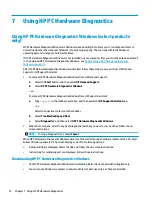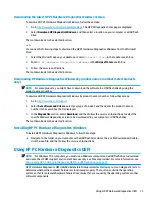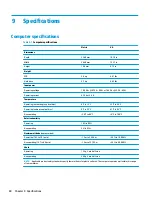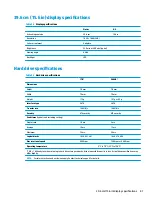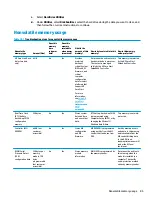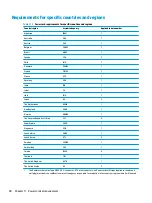
Table 10-1
Troubleshooting steps for nonvolatile memory usage (continued)
Nonvolatile
memory type
Amount (Size)
Does this
memory
store
customer
data?
Does this
memory
retain data
when power
is removed?
What is the
purpose of this
memory?
How is data entered into this
memory?
How is this memory
write-protected?
System BIOS
9 MB
Yes
Yes
Stores system
BIOS code and
computer
configuration
data.
System BIOS code is
programmed at the factory.
Code is updated when the
system BIOS is updated.
Configuration data and
settings are entered using
the Computer Setup (BIOS) or
a custom utility.
NOTE:
Writing data to
this ROM in an
inappropriate manner can
render the computer non-
functional.
A utility must be used for
writing data to this
memory and is available
on the HP website; go to
. Select Find your
product, and then follow
the on-screen
instructions.
Intel Management
Engine Firmware
(present only in
select Elite or Z
models. For more
information, go to
. Select
Find your
product, and then
follow the on-
screen
instructions.)
1.5 MB or 7 MB
Yes
Yes
Stores
Management
Engine Code,
Settings,
Provisioning
Data and iAMT
third-party data
store.
Management Engine Code is
programmed at the factory.
Code is updated via Intel
secure firmware update
utility. Unique Provisioning
Data can be entered at the
factory or by an
administrator using the
Management Engine (MEBx)
setup utility. The third-party
data store contents can be
populated by a remote
management console or local
applications that have been
registered by an
administrator to have access
to the space.
The Intel chipset is
configured to enforce
hardware protection to
block all direct read/write
access to this area. An
Intel utility must be used
for updating the
firmware. Only firmware
updates digitally signed
by Intel can be applied
using this utility.
Bluetooth flash
(select products
only)
2 Mb
No
Yes
Stores
Bluetooth
configuration
and firmware.
Bluetooth flash is
programmed at the factory.
Tools for writing data to this
memory are not publicly
available but can be obtained
from the silicon vendor.
A utility must be used for
writing data to this
memory and is made
available through newer
versions of the driver
whenever the flash
requires an upgrade.
802.11 WLAN
EEPROM
4 Kb to 8 Kb
No
Yes
Stores
configuration
and calibration
data.
802.11 WLAN EEPROM is
programmed at the factory.
Tools for writing data to this
memory are not made public.
A utility must be used for
writing data to this
memory and is typically
not made available to the
public unless a firmware
upgrade is necessary to
address a unique issue.
Camera (select
products only)
64 Kb
No
Yes
Stores camera
configuration
and firmware.
Camera memory is
programmed using a utility
from the device
manufacturer that can be run
from Windows.
A utility must be used for
writing data to this
memory and is typically
not made available to the
public unless a firmware
86
Chapter 10 Statement of memory volatility

